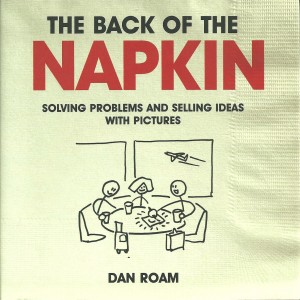The one-sentence summary
Many problems can be solved more easily, and ideas conveyed better, with pictures rather than words.
WHAT THE BOOK SAYS 
- This book is all about solving problems and selling ideas with pictures.
- Used properly, a simple drawing on a humble napkin is more powerful than a spreadsheet or a PowerPoint chart. It can help crystallise ideas and communicate in a way that other people ‘get’.
- Everyone is born with a talent for visual thinking, even those who swear they can’t draw.
- You have three basic visual thinking tools: Eyes, Mind’s Eye, and Hand-Eye coordination.
- The visual thinking process has four steps:
1. Look (collecting and screening)
2. See (selecting and clumping). Collect everything you can, lay it all out where you can look at it, establish fundamental coordinates, and practise visual triage (sort and prioritise).
3. Imagine (seeing what isn’t there)
4. Show (making it all clear)
- The SQVID process involves generating five quick drawings about the issue:
Simple (or elaborate)
Qualitative (or quantitative)
Vision (or execution)
Individual (or comparison)
Delta – the Greek symbol for Change (or status quo)
- The 6 Ws gives us six ways to see and show problems:
1. Who and what (challenges relating to things, people and roles): draw a portrait
2. How much (measuring and counting): draw a chart
3. When (scheduling and timing): draw a map
4. Where (direction and how things fit together): draw a timeline
5. How (how things influence one another): draw a flowchart
6. Why (seeing the big picture): draw a multiple variable plot
- Combine the SQVID and the 6 Ws and you create a Visual Thinking Codex.
WHAT’S GOOD ABOUT IT
- There are three types of people: Black pen (hand me the pen), Yellow pen (I can’t draw but…happy to add to other drawings), and 3. Red pen (I’m not visual)
- Regardless of which you are, the system works. If you are making a presentation you can work through the system and crack your problem visually. It will tell you what chart you require.
WHAT YOU HAVE TO WATCH
- You can skim, but it’s better to take a real presentation and work it through.
